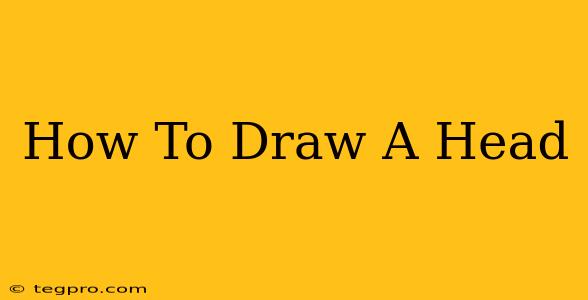Learning to draw a realistic head can seem daunting, but with the right approach and a little practice, you'll be surprised how quickly you can improve. This guide breaks down the process into manageable steps, perfect for beginners. We'll cover fundamental shapes, proportions, and features to help you create believable and expressive head portraits.
Understanding Basic Head Proportions
Before diving into details, let's establish a foundational understanding of head proportions. This will serve as your roadmap for accuracy and consistency.
The Basic Egg Shape:
Start by sketching a slightly elongated egg shape. This forms the basic structure of the head. This initial shape guides your overall form and helps avoid common mistakes in proportion.
Finding the Center Line:
Draw a vertical line down the center of the egg. This line is crucial for placing features symmetrically. It acts as your guide for ensuring eyes, nose, and mouth are evenly aligned.
Dividing the Head:
Now, divide the egg shape into thirds using two horizontal lines. The top line will roughly mark the hairline, the middle line will indicate the eyebrows and the bottom line roughly shows the base of the nose. This proportional guideline is a crucial step.
Adding Facial Features
With the basic structure in place, it's time to add the key facial features. Let's focus on placement and shape for now. We'll refine details later.
Eyes:
Position the eyes along the middle horizontal line. The distance between the eyes is usually about one eye width apart. Each eye is almond-shaped. Practice drawing different eye shapes and expressions to develop your skill.
Nose:
The nose typically starts at the bottom horizontal line (base of the nose) and extends downwards. Simplify the shape initially; you can add finer details later. Consider the overall shape of the nose – is it long and narrow, short and wide, or something in between?
Mouth:
The mouth is positioned below the nose, with the corners roughly aligning with the inner corners of the eyes. The size and shape of the mouth vary greatly, so observe and practice drawing different mouth shapes.
Ears:
Ears typically start at the level of the eyebrows and extend to the bottom of the nose. Consider the position and shape of the ears which are unique.
Refining the Details
Once you have the basic features in place, you can start to refine the drawing by adding more details.
Shading and Light:
Shading is crucial for creating depth and volume in your drawing. Observe how light falls on the face and use shading to enhance these areas. This will greatly enhance the realism.
Hair:
Hair is unique to each person so observe its flow and style before starting to draw it. Consider its volume, texture, and direction to create a convincing representation.
Neck:
Don't forget the neck! The neck connects the head to the body. Draw it appropriately to make sure your drawing has a natural look and feel.
Practice Makes Perfect
Learning to draw a head takes time and effort. Don't get discouraged if your first attempts aren't perfect. The key is consistent practice. Experiment with different techniques, use references like photos, and focus on refining your skills gradually.
Resources for Further Learning
Numerous online resources like YouTube tutorials and online drawing courses can significantly help refine your drawing skills. Consider seeking out more advanced tutorials as you progress.
By following these steps and practicing regularly, you'll be well on your way to drawing realistic and expressive heads. Remember, patience and persistence are essential keys to becoming a skilled artist.

